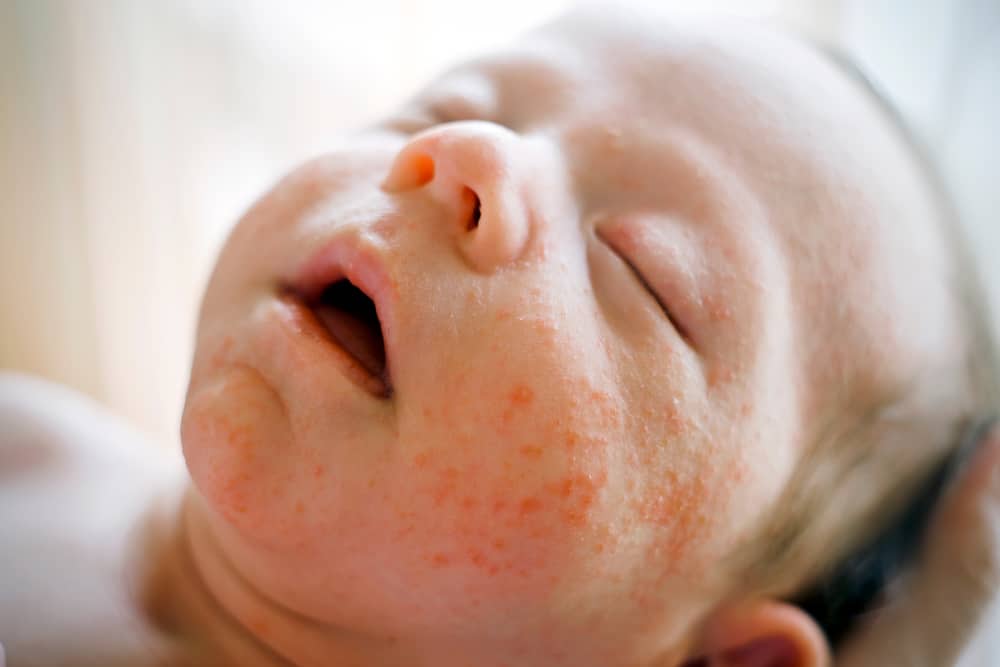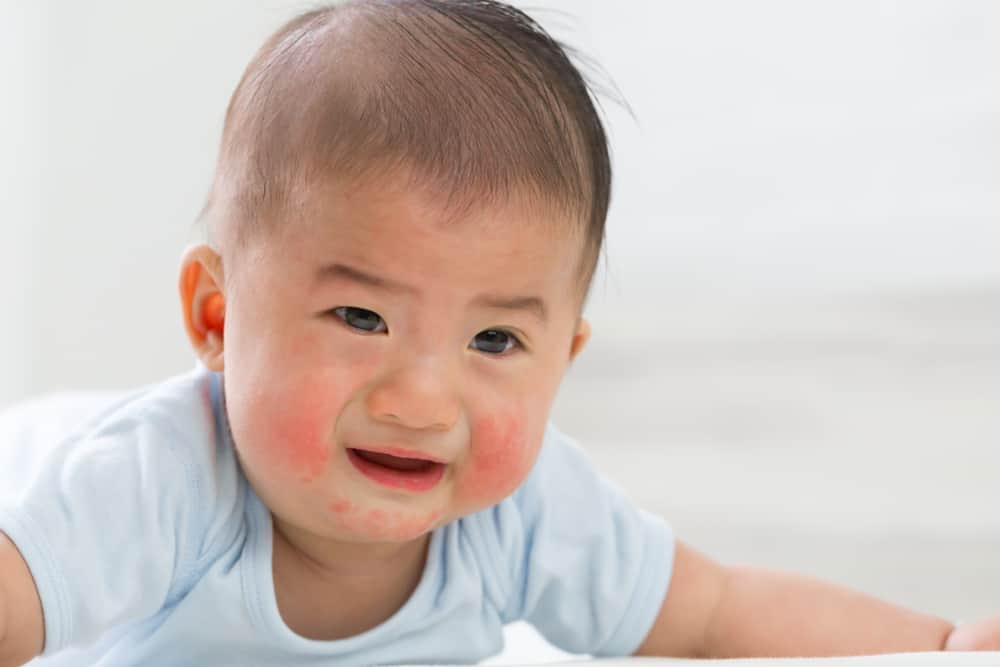Acne in Babies, What Causes it and How to Overcome It?
Usually, acne is one of the skin problems that teenagers often experience during puberty. In addition, acne often occurs in adults when they feel stressed or do not clean their skin properly. However, not only them, children and even babies can also have acne. What causes acne in babies and how to deal with it?
What do acne marks on baby’s skin look like?
Acne in babies is a sign that the baby’s skin is still very sensitive. Acne is a harmless baby skin problem.
Quoting from the Mayo Clinic, the first sign of acne on your little one’s skin is a red spot that causes the surrounding area to become red if it is elastic filled with pus (whiteheads) develop.
These pimples can appear around the cheeks, chin, forehead, or even on the baby’s back. This condition can occur after a new baby is born or about two or four weeks after being born.
Acne in babies usually appears and lasts about 2 to 4 weeks after the baby is born. However, this acne can also appear until the first three months after the baby is born, then it will disappear by itself in a few months (usually 3-4 months).
So, you don’t need to worry because acne only appears temporarily. You can take care of your baby’s discomfort.
Indeed, at this time, babies are usually more fussy and cry when a rough object or saliva hits the pimple.
What causes acne in babies?

It’s not clear what causes acne in babies. Reporting from the Baby Center, experts suspect that the hormone the baby receives from its mother at the end of pregnancy can be the cause of acne in babies.
In some cases, baby skin care products, especially oily ones, can block the pores on the baby’s face, causing acne breakouts.
In addition, taking certain medicines while breastfeeding or if the baby is taking certain medications can also be a cause of acne in the baby.
Your little one will feel uncomfortable with acne conditions that appear on the skin when experiencing:
- Overheating body
- Skin irritation from saliva or sweat
- The fabric or fabric is too rough
Acne makes your little one’s skin uncomfortable when the above conditions occur. Prevent your little one from being fussy by keeping the baby’s body dry, not sweating, and wearing soft baby clothes.
Skin conditions that resemble baby acne
There are several skin conditions that are similar to acne on the skin of your baby, but they are not. These conditions are eczema, milia, and erythema toxicum, the explanation is as follows:
Eczema
This skin condition usually appears with red bumps on the face and is very likely to appear on the skin and elbows as your little one gets older.
In severe conditions, eczema or atopic dermatitis in infants who are already infected can make dry skin yellow and crusty. This condition gets worse when the baby learns to crawl and scrape your little one’s knees and elbows.
There are two types of eczema that most babies experience, atopic dermatitis and seborrheic dermatitis. Eczema can be treated using mild ointments prescribed by doctors. You cannot carelessly apply medicine to your little one’s skin.
The doctor will ask you to remove foods that trigger allergies. In addition, the doctor will prescribe probiotics to be given to your little one as a way to reduce eczema in babies.
Toxic erythema
This is a skin condition that appears as a rash, small bumps, or red patches. Usually can be seen on the face, chest, back in the first few days after the baby is born.
Toxic erythema is harmless because it goes away in less than a week after your little one is born.
Milia
This is a condition when small white spots appear on the skin of the baby’s face. Milia occur when dead skin cells get trapped under the skin and do not require special treatment.
Milia in babies are also present a few weeks after birth and will go away on their own.
How long has the pimple been on the baby’s skin?
Usually, pimples on your little one’s skin will appear shortly after birth and then disappear a few weeks later. The longest until the baby is six months old.
Will the acne leave scars, like acne in adults? No need to worry, pimples on your little one’s skin will not leave scars and are not permanent like adults.
How to treat acne in babies?

This condition is common and can resolve on its own within days, weeks, or months. However, doing home care can help your baby’s skin heal faster and make baby’s skin healthier.
Here are the tipstake care of the skin babies with acne:
1. Clean using warm water
Although baby acne will disappear on its own, the American Academy of Dermatology (AAD) recommends that you continue to care for your baby’s skin by cleaning it with warm water.
The point of warm water here, is not hot but tends to be cold or lukewarm water. Water that is too warm tends to be hot, which can irritate the skin and make your little one uncomfortable.
Routinely cleaning the baby’s face with warm water helps care baby skin order more clean from leftovers,Breast milk, saliva, and of course bacteria or germs.
How to clean by preparing a soft cloth or cloth that has been previously soaked in warm water.
2. Avoid rubbing the baby’s skin
After cleaning with warm water, wipe the baby’s skin with a soft towel. Avoid rubbing the baby’s skin hard, which can cause irritation.
When it has been cleaned, dry it with a dry towel or cloth by tapping it gently. Although it aims to clean the baby’s skin, washing the baby’s face is only done once a day and no more.
3. Avoid cleaning using wet wipes
The next way to deal with acne on baby’s skin is to clean the area of the baby’s mouth that often salivates. Clean using a dry tissue for avoid saliva irritating pimples around the chin.
Avoid using wet wipes, which usually contain alcohol and fragrances, which can sting and dry the baby’s skin. You can use soap for the baby’s dry skin to make it softer and smoother.
4. Do not use skin care products carelessly
For babies who are only a few months old, using care products is likely to cause irritation.
Applying oily lotion to your baby’s skin will also make acne worse because it blocks the pores of the skin.
Not only that, avoid using acne medication without a doctor’s prescription. If you get skin care products from a doctor, use them as directed.
When consulting a doctor, usually a cream will be recommended to treat acne in children. In cases so severe that they are injured, the doctor may prescribe antibiotics to prevent inflammation.
5. Use clothes with buttons
If pimples appear around the cheeks, avoid pinching the cheeks. This will injure and irritate the baby’s skin due to acne.
For the time being, wear button-down clothes, this will prevent the acne-prone skin from rubbing if the clothes are used directly from the top of the head.
In doing baby skin care with acne, you have to be patient. The feeling of worry must arise because the baby becomes uncomfortable and cries a lot.
If the baby’s acne does not disappear within three months, you should immediately have his skin checked by a doctor. Actually there is no special treatment to cure your little one’s acne. It is likely that the doctor will recommend the use of medication or ointment as treatment.
When to see a doctor

If you feel that your baby’s acne doesn’t go away (more than 4-6 months) or your acne is getting worse, it’s best to get your baby checked by a doctor.
Your doctor may prescribe a mild topical medication to treat your baby’s acne. Baby pimples that keep appearing and don’t go away can be a sign that your child will have a problem with acne as a teenager.
Not only that, red spots on baby’s skin are also not the only sign of baby acne.
There are several conditions that cause the appearance of red spots on the baby’s skin and are usually accompanied by other symptoms, such as fever. Perform further tests if these conditions occur.
Hello Health Group does not provide medical advice, diagnosis or treatment.